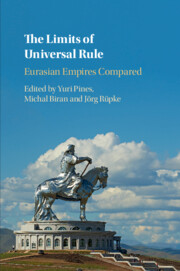Refine search
Actions for selected content:
23990 results in Ancient history
6 - The Mongol Imperial Space
-
-
- Book:
- The Limits of Universal Rule
- Published online:
- 07 January 2021
- Print publication:
- 21 January 2021, pp 220-256
-
- Chapter
- Export citation

Rulers and Ruled in Ancient Greece, Rome, and China
-
- Published online:
- 19 January 2021
- Print publication:
- 04 February 2021

The Transformation of the Roman West
-
- Published by:
- Amsterdam University Press
- Published online:
- 15 January 2021
- Print publication:
- 28 February 2018
-
- Book
- Export citation

The Limits of Universal Rule
- Eurasian Empires Compared
-
- Published online:
- 07 January 2021
- Print publication:
- 21 January 2021
Part IV - The Aftermath
-
- Book:
- The Cambridge Companion to the Council of Nicaea
- Published online:
- 17 December 2020
- Print publication:
- 07 January 2021, pp 223-324
-
- Chapter
- Export citation
Appendix 1: - The Signatories
- from Appendices
-
- Book:
- The Cambridge Companion to the Council of Nicaea
- Published online:
- 17 December 2020
- Print publication:
- 07 January 2021, pp 368-375
-
- Chapter
- Export citation
Abbreviations
-
- Book:
- The Cambridge Companion to the Council of Nicaea
- Published online:
- 17 December 2020
- Print publication:
- 07 January 2021, pp xvi-xx
-
- Chapter
- Export citation
8 - The Twenty Canons of the Council of Nicaea
- from Part III - Outcomes
-
-
- Book:
- The Cambridge Companion to the Council of Nicaea
- Published online:
- 17 December 2020
- Print publication:
- 07 January 2021, pp 158-176
-
- Chapter
- Export citation
Part I - Contexts
-
- Book:
- The Cambridge Companion to the Council of Nicaea
- Published online:
- 17 December 2020
- Print publication:
- 07 January 2021, pp 17-62
-
- Chapter
- Export citation
6 - The Elephant in the Room
- from Part II - The Council
-
-
- Book:
- The Cambridge Companion to the Council of Nicaea
- Published online:
- 17 December 2020
- Print publication:
- 07 January 2021, pp 111-132
-
- Chapter
- Export citation
Index
-
- Book:
- The Cambridge Companion to the Council of Nicaea
- Published online:
- 17 December 2020
- Print publication:
- 07 January 2021, pp 416-424
-
- Chapter
- Export citation
10 - Narrating the Council
- from Part III - Outcomes
-
-
- Book:
- The Cambridge Companion to the Council of Nicaea
- Published online:
- 17 December 2020
- Print publication:
- 07 January 2021, pp 202-222
-
- Chapter
- Export citation
1 - Introduction
-
-
- Book:
- The Cambridge Companion to the Council of Nicaea
- Published online:
- 17 December 2020
- Print publication:
- 07 January 2021, pp 1-16
-
- Chapter
- Export citation
Part V - The Long Reception
-
- Book:
- The Cambridge Companion to the Council of Nicaea
- Published online:
- 17 December 2020
- Print publication:
- 07 January 2021, pp 325-367
-
- Chapter
- Export citation
Part II - The Council
-
- Book:
- The Cambridge Companion to the Council of Nicaea
- Published online:
- 17 December 2020
- Print publication:
- 07 January 2021, pp 63-132
-
- Chapter
- Export citation
3 - Arius and Arianism
- from Part I - Contexts
-
-
- Book:
- The Cambridge Companion to the Council of Nicaea
- Published online:
- 17 December 2020
- Print publication:
- 07 January 2021, pp 43-62
-
- Chapter
- Export citation
16 - Catholic Reception of the Council of Nicaea
- from Part V - The Long Reception
-
-
- Book:
- The Cambridge Companion to the Council of Nicaea
- Published online:
- 17 December 2020
- Print publication:
- 07 January 2021, pp 347-367
-
- Chapter
- Export citation
Contributors
-
- Book:
- The Cambridge Companion to the Council of Nicaea
- Published online:
- 17 December 2020
- Print publication:
- 07 January 2021, pp xii-xiii
-
- Chapter
- Export citation
13 - Apollinarius and the Nicene Homoousion
- from Part IV - The Aftermath
-
-
- Book:
- The Cambridge Companion to the Council of Nicaea
- Published online:
- 17 December 2020
- Print publication:
- 07 January 2021, pp 282-304
-
- Chapter
- Export citation
15 - The Legacy of the Council of Nicaea in the Orthodox Tradition
- from Part V - The Long Reception
-
-
- Book:
- The Cambridge Companion to the Council of Nicaea
- Published online:
- 17 December 2020
- Print publication:
- 07 January 2021, pp 327-346
-
- Chapter
- Export citation
